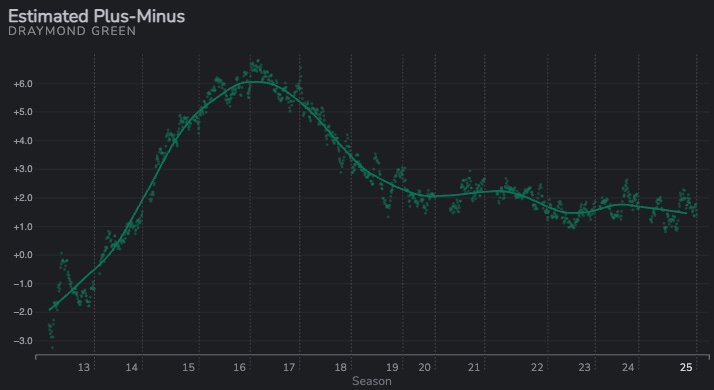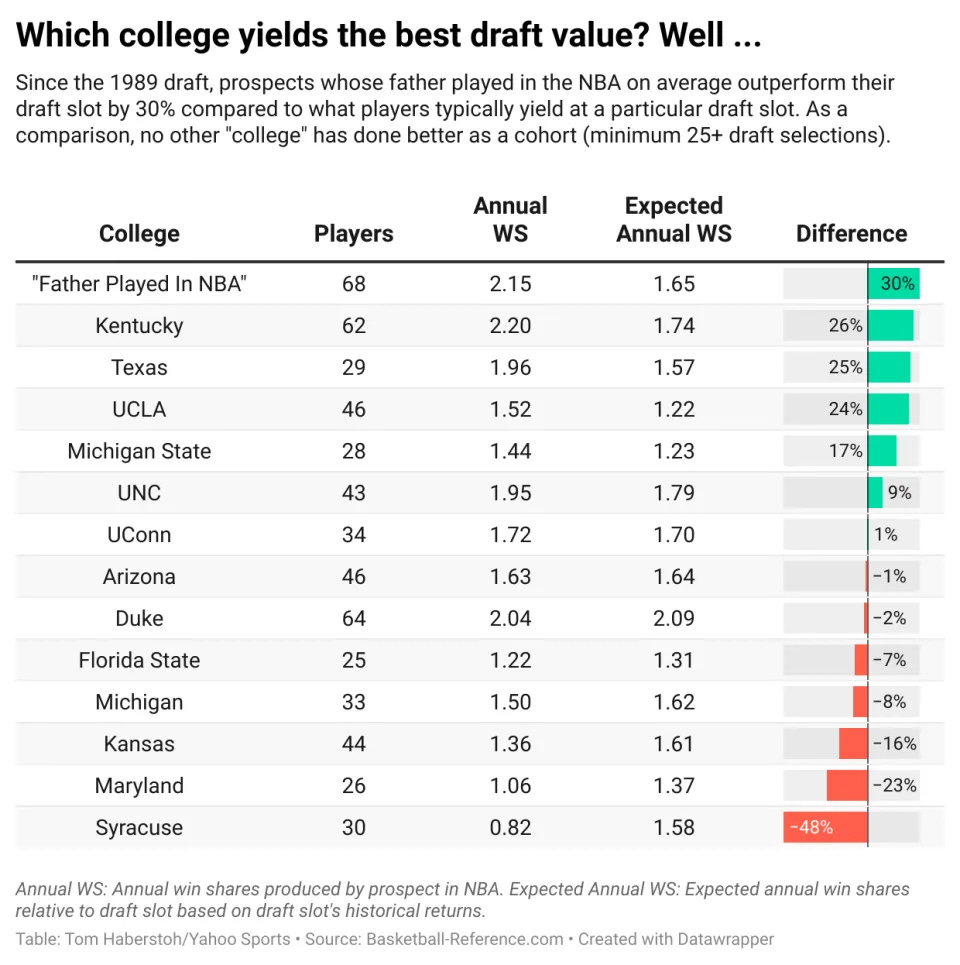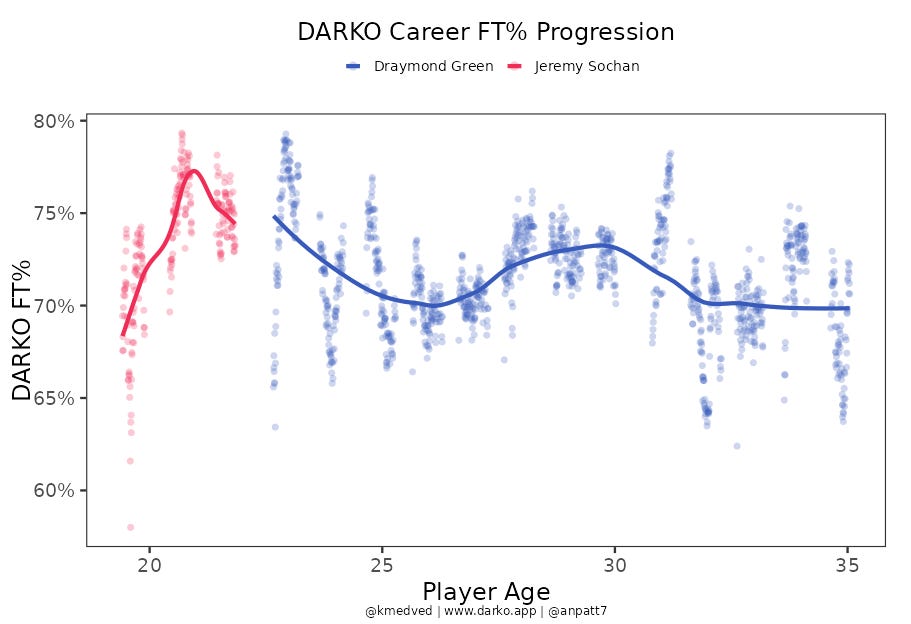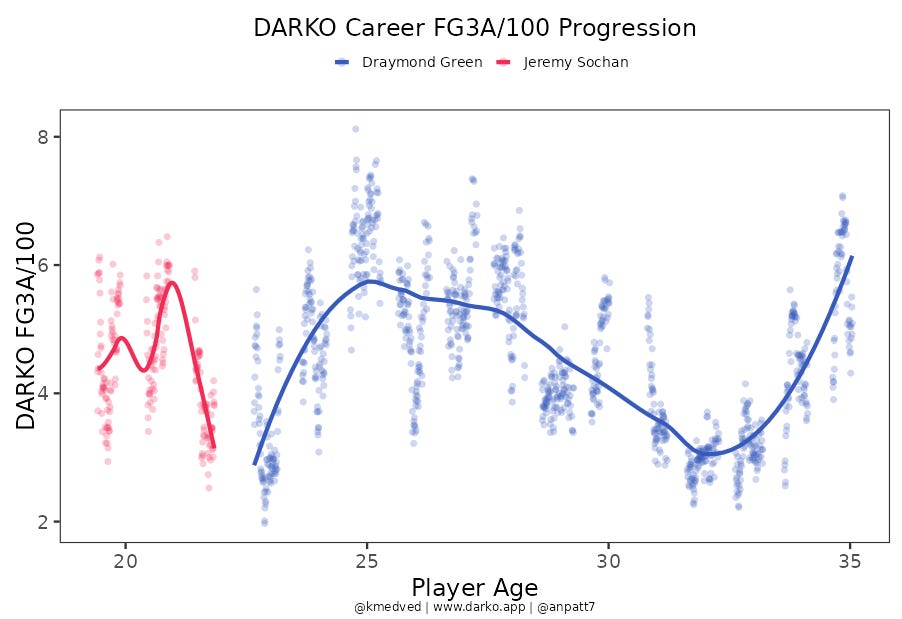Reaching the Boyling Point
Why the NBA Draft Market is Incorrect on Collin Murray-Boyles
Collin Murray-Boyles is 13th on the RookieScale.com consensus board as of 6/18/2025. The NBA draft market is incorrect on CMB. Here is why.
The Case Against CMB
CMB is a non-shooter so he has to play center and he is very undersized at 6’6.5” height without shoes.
CMB was productive in college but generated a bunch of his offense from post-ups, which he is unlikely to translate to the NBA level as a shorter player.
CMB’s individual performance was not able to carry over to team performance as South Carolina finished last in the SEC.
But if we take a deeper look the case is not so strong.
CMB vs. His Teammates
The easiest point to disprove is the one about South Carolina’s performance and CMB’s part in it. South Carolina finished last in the SEC in 2024-25, but the 2024-25 SEC was one of the greatest conferences of all-time. From KenPom’s Thoughts:
Indeed, based on non-conference play, the SEC has been one of the best leagues of the internet era, and therefore, possibly ever. The conference produced the best non-conference winning percentage over that time and the best scoring margin since the 1997 ACC
South Carolina was still the 69th-ranked KenPom team in 2024-25 and 54th in 2023-24. That is still not great but Rutgers was ranked 70th in 2024-25, and similar to my Dylan Harper analysis:
Harper Hype: Hipsters or the Herd?
Dylan Harper is the consensus 2nd-ranked prospect in the 2025 NBA Draft, but the “hipster” Draft Twitter-sphere is consistently lower on him than consensus. And some public draft models are lower on him, too. The consensus is correct and Draft Twitter is incorrect in this case. Here is why.
much like Harper dragged Rutgers up to that level despite awful teammates, CMB also put South Carolina on his back so they could finish as well as they did. My player ratings have nobody else on South Carolina in the top 500 players in college basketball in either 2023-24 during CMB’s freshman season or 2024-25 during CMB’s sophomore season.
On the other hand, CMB’s impact metrics are incredible in both his freshman season:
10.3 cbb ref BPM (6.0 offense, 4.3 defense)
9.5 Torvik BPM (5.7 offense, 3.8 defense)
4.1 Miya BPR (2.4 offense, 1.7 defense)
And his sophomore season:
11.9 cbb ref BPM (6.9 offense, 5.0 defense)
11.1 Torvik BPM (6.6 offense, 4.6 defense)
5.8 Miya BPR (3.1 offense, 2.8 defense)
And my own model has CMB much closer to cbb ref and Torvik, as opposed to Miya.
Searching for the Next Draymond
But unlike Harper did with the Rutgers offense,1 CMB’s offensive production was unable to raise the floor of the South Carolina offense.2 And his offensive post production is unlikely to translate to the next level when he is undersized for a center.
But that is not a death sentence because nobody is projecting CMB to be a high-usage post hub that raises a team’s offensive floor at the next level. Rather, CMB profiles more as a lower-usage ceiling raiser, who provides elite defense and great connective offense to amplify the stars around him. The potential upside would be for CMB to become something like one of the most underrated players of the 21st century, Draymond Green, whom public impact metrics adore. And those metrics might actually underrate him due to his ramping up effort and providing a skillset that plays up as a “16-game player” instead of an “82-game player”.
As Ben Falk of Cleaning the Glass wrote:
The Death Lineup is all about Draymond Green — he is what makes that lineup so unique, the lead rider of the Five Horsemen of the Basketball Apocalypse. If other teams wanted to copy what Golden State had found, they first had to find their own Draymond. And how many players have the size and strength to wrestle with the league’s behemoths, the intellect and agility to switch onto the best guards, and the shooting and passing to make opponents pay from the perimeter?
But Draymond has been at least a passable shooter at the NBA level and, more importantly, Draymond is a contender for greatest basketball IQ of all-time. Teams have longed to find a player that replicates his skillset but Draymond has thus far proven to be a one-of-one. The Ben Falk quote above is from a Cleaning the Glass article on the 2017-18 Rockets playing PJ Tucker at center for a chance to recreate their own Death Lineup to match up with the dynastic Warriors.3 And as a draft prospect Jeremy Sochan also had shades of becoming something like Draymond, but has so far disappointed at the NBA level. From deanondraft’s scouting report:
Sochan has been frequently compared to Dennis Rodman for changing his hair color, and his pest like approach to the game where he regularly irritates his opponents. But stylistically, his freshman numbers are more similar to another player with a colorful personality.
Draymond was a bit better rebounding and passing, but Sochan 2.5 months younger and played a bigger freshman role averaging 25 mins/game compared to 11 mins for Draymond. Sochan also attempted substantially more 3PA, but that may be a product of the modern era more than anything.
So it might seem like saying CMB has a chance to become something like Draymond is just the latest in a line of wishful thinking to find a non-existent copy of a one-of-one. But I am not the only person who has that sentiment. Jerry Engelmann, former analyst for the Suns and Mavericks had the same thought:
While everyone is always looking for the next Draymond Green, without finding him, the film makes it clear that CMB is a strong candidate.
How Does CMB Stack Up?
Comparing CMB, Draymond, and Sochan’s physical tools and statistical profiles might give us a clue towards how far-fetched the Draymond comparison might be.
CMB
19.0 draft day age after freshman season (20.0 during draft season)
6’6.5” and 239 lbs
7’0.75” wingspan and 8’10” standing reach
3.15 3/4 court sprint and 29.5 standing vert
Draymond
19.3 draft day age after freshman season (22.3 during draft season)
6’5.75” and 236 lbs
7’1.25” wingspan and 8’9” standing reach
3.40 3/4 court sprint and 28 standing vert
Sochan
19.1 draft day age after freshman season
6’11.75” wingspan6
skipped combine measurements and athletic testing
CMB’s physical comparison is favorable, especially when factoring in his strength, with the only deficiency being half an inch of wingspan compared to Draymond. Like Draymond, CMB’s size and length still profile better as an NBA power forward. But the two are less undersized than they appear due to having much better length than height. That size and length is just good enough to play as a small-ball center in switch-heavy defensive schemes if it comes with a high defensive basketball IQ.
We should mentally deflate CMB’s freshman season stats a bit, as it was the only player-season below without a top 25 KenPom strength of schedule.78
CMB per 40:
Draymond per 40:
Sochan per 40:
CMB Advanced:
Draymond Advanced:
Sochan Advanced:
CMB Torvik:
Draymond Torvik:9
Sochan Torvik:
Making Sense of the Stats
My takeaways from the data dump above are the following:
CMB’s overall impact was closer to (even slightly better than) Draymond’s than Sochan’s, especially when considering the Baylor zone (more on this below). It is also worth noting that my own model has CMB’s freshman season as a clear step above Sochan’s freshman season, in contrast to how close the comparison is using Torvik BPM and cbb ref BPM.
Draymond’s assist rate was crazy high for a non-point guard from his sophomore season on, potentially serving as an early indicator of his outlier basketball IQ. While his freshman AST/TOV was positive, his freshman AST%/TOV% was not, highlighting the fact that he played with Michigan St teammates who were very talented at scoring the ball.
CMB also had a very high assist rate but his sophomore season was not quite as elite as Draymond’s sophomore season. CMB had a negative AST/TOV ratio in 2024-25, but his AST%/TOV% was much stronger, highlighting the fact that his 2024-25 South Carolina teammates simply could not put the ball in the basket, hampering CMB’s raw assist numbers.
In contrast with CMB’s sophomore season, Sochan’s freshman AST/TOV ratio was positive, but his AST%/TOV% told a different story, highlighting the fact that his 2021-22 Baylor teammates were much more adept at scoring the ball, benefitting Sochan’s raw assist numbers.
Draymond was a bit better at rebounding than CMB and Sochan.
CMB was a bit better than Draymond and Sochan at dunking the ball, despite having worse teammates.
CMB > Draymond > Sochan in terms of FT%, but Sochan let it fly from three and Draymond played in an earlier era for a coach who has always had extremely low offensive 3FGA rates.10 There may be more signal in CMB not attempting as many threes in a more three-friendly era.
CMB’s defensive event creation and stock/foul rate was actually better than Draymond’s. Sochan appears in a similar ballpark to the two, but given Baylor has historically played lots of zone defense, it is fair to deflate Sochan’s stock rates and even question the translatability of Sochan’s box score defense to the next level:
That last point might be a key overlooked factor that would explain a large portion of Sochan’s underperformance so far at the NBA level. Tom Haberstroh’s analysis on pro bloodlines, which I discussed in my Harper article, came with the following plot:
As I mentioned in a footnote in the Harper article:
Astute readers will also notice the Syracuse bar on the other end, consistent with studies that show zone defenses inflate players’ defensive stats.
So my overall takeaway is that CMB is surprisingly similar to Draymond, and much more so than Sochan ever was. Draymond has edges in assists and overall defensive impact, potentially highlighting his better basketball IQ. But Draymond also had the benefit of playing with better teammates and a legendary head coach whose teams have only finished outside of the top 50 in KenPom defense twice in the last 20 years. CMB has edges in athleticism and rim ability, despite having to carry a heavier offensive self-creation load. And CMB’s better stock-to-foul is also an interesting data point on the defensive side of the ball.
But Can He Shoot?
From the same Jerry Engelmann article mentioned above: “There is one big issue, though: He doesn’t, and apparently can’t, shoot 3s.” And Jerry wrote that before bad shooting at the combine.
But combine shooting is a small sample and Draymond did not shoot threes before reaching the NBA either. And, taking uncertainty into account with 90% confidence intervals,11 each player’s FT% and each player’s mid-range 2-point FG% is basically indistinguishable from the others:
FT%:
CMB: 64.6% - 74.0%
Draymond freshman and sophomore seasons: 59.3% - 71.4%
Draymond college career: 65.1% - 72.1%
Sochan: 49.7% - 67.7%
Mid-range 2-point FG%:
CMB: 32.7% - 48.0%
Draymond sophomore season: 34.1% - 49.6%
Draymond sophomore through senior seasons: 32.5% - 40.4%
Sochan: 29.8% - 51.6%
Given all of the available information I would obviously not project CMB to be a good shooter at the NBA level. But given the potential for non-shooting bigs to improve their shooting ability over time, I think CMB is a reasonable bet to at least develop a passable three point shot.
Projecting CMB
And while the bar for shooting to get on the floor in the NBA has increased over time, what has distinguished Draymond from Sochan is not really shooting ability:
Rather, Draymond is Draymond in spite of just passable shooting mainly due to his basketball IQ translating to passable offense (or good offense when his athletic prime coincides with seasons in which he shoots the ball particularly well):
with DPOY-level defense:
It seems foolish to project CMB to be one of the greatest of all-time in basketball IQ. But CMB’s athletic advantages, comparable stats, and good film do imply a good chance of a similar level of defensive ability and passing ability at the NBA level. So I think there is a good chance that CMB becomes a lite version of Draymond on the defensive end.
CMB’s offensive projection is more interesting. A non-shooter on offense is best utilized either 1) with the ball in their hands or 2) as a screener. The issue with the latter for power forward-sized players like Draymond, Sochan, and CMB, is that it is difficult to find a center who is a good enough shooter to maintain 4-out floor spacing so that the bulk of screening work can be done by the power forward. And the issue with the former is that there is a high ball-handling, scoring, and decision-making bar to clear in order to be trusted with the ball in your hands at the NBA level.
Nevertheless, for a while the Spurs experimented with “point-Sochan,” much to the chagrin of Spurs fans who wanted to move on to optimizing the team around Victor Wembanyama after San Antonio won the 2023 lottery for the generational prospect. But the theory behind the experiment, at least before Wemby was in the picture, made it worth trying for a rebuilding team, even if the results did not end up working out in this case.
And there is reason to believe that trying out “point-CMB” has a better chance of working out than “point-Sochan” ever did. As discussed above, after adjusting for quality of teammates it seems to me that CMB was a much better passer than Sochan was in college. And CMB also self-created offense from the perimeter in a way that Sochan did not. So there does seem to me to be a chance, however small, of actualizing CMB’s potential with an on-ball offensive role as well — something like a halfcourt version of early-career Ben Simmons, who uses his strength to get to the rim — at least for short stretches of NBA games.
It is much more likely that CMB’s offensive role is much more scaled down to being a screener and short-roll passer. But between the potential to develop good-enough shooting and to have an on-ball offensive role in certain lineups I think public consensus is underpricing his expected offensive potential. Combined with a good chance of being a less outlier-y version of Draymond on defense puts CMB at 4th on my big board, in my 3-7 tier of players.
A Premortem on Why My Projection is Incorrect
The easiest way for my projection to be an over-estimate is if there was better information about CMB’s lack of ability to develop a three point shot, despite promising enough FT% and mid-range 2-point jump shot FG%. I am not familiar with the forefront of performance science research in shot trajectories and biomechanics, but to my untrained eye, the small sample of CMB’s spot-up shooting looked to me like it included some very bad misses, which are likely more predictive than binary make/miss.
My shooting workout thoughts in my analysis of Ace Bailey also hold for CMB, albeit less strongly due to CMB’s value proposition being more about developing future shooting ability as opposed to displaying current shooting ability:
For example, you may have brought Ace in for a shooting workout where he shot 500-1000 threes22 and have a better idea of how he stacks up as a shooter. However, note that in 1-on-0 workouts where a player can get into a consistent rhythm even complete non-shooter types often hit about 40%, 30% in-game 3FG% shooters often hit around 60%, while elite shooters hit closer to 80-90%, according to former Sidwell Friends and Georgetown basketball coach Benj Coen.
And even though I think CMB has some on-ball potential, there is still a very small chance that he actualizes it at the NBA level. So in that scenario it is overwhelmingly likely that he is a negative offensive player for the majority of his career.
And I could just be displaying the latest in a long line of wishful thinking searching for a chance to replicate a one-of-one defensive IQ superstar. CMB’s statistical profile is similar to Draymond, but assists, steals, and fouls are obviously imperfect proxies for basketball IQ. I myself have not watched CMB nearly enough to have a differentiated opinion from the crowd of how elite or not his basketball IQ might be. If CMB does not perform to at least a Draymond-lite level on the defensive end, it would be a useful data point going forward that would imply we should place much more weight on scouting the very top of the basketball IQ distribution at the expense of putting weight on statistical proxies and similar physical tools.
Rutgers’ offense ranked 55th on KenPom in 2024-25.
South Carolina’s offense ranked 102nd on KenPom in 2024-25.
They did get shockingly close, and it took a Chris Paul injury and a legendarily unlucky 7/44 three point shooting performance for the Rockets to lose the 2018 Western Conference Finals to the Warriors.
According to CraftedNBA.com
According to bbref
According to CraftedNBA.com
Draymond’s freshman season was pre-cbb ref complete per 100 possessions data availability, but the per minute comparisons should be mostly fine because each player’s team-seasons had KenPom raw Tempo values < 5% faster/slower than each other.
Interestingly 2024-25 South Carolina’s 22nd-ranked +14.6 SoS was actually more difficult than 2010-11 Michigan St’s 1st-ranked +13.7 SoS, a reflection of conference realignment and NIL creating a more top-heavy college basketball landscape in 2024-25.
Note that detailed shot data, including dunks and mid-range twos (“Far Twos” on Torvik) are not available for Draymond’s freshman season.
Check out Tom Izzo’s KenPom coach page.
All models are wrong, but some are useful, including this assumption of treating all of a player’s free throws as independent and identical coin flips.





















Just watched his highlights. He moves a bit like Draymond. When I watch Draymond it feels like he’s wearing incredibly heavy shoes with magnets in them. Like he plods around a lot of the time. But the magnets can connect to something in the floorboards, and he has a switch in his brain to control them, so, whenever he feels like it, he can turn them on and make himself unmovable in the post. But the magnets can also generate momentum over very short distances so he also uses them to randomly start flying across the lane or to get a little extra zip on a fast break.
Good read. I'm also a huge CMB fan. Have him 5th on my big board right now. When's your full big board come out? I see a lot of people doing the Draymond comparison, but don't like it as much on the offensive end. Draymond as a 22.3 year old senior shot only 0.473 on 2P%, while CMB was really efficient from 2P% as a 19 year old freshman (0.613) and 20 year old sophmore (0.622). I have another DPOY big as a comparison for CMB, Evan Mobley. I used machine learning to map out predraft neighbours for each prospect and Mobley was one of CMB's. CMB as a sophomore was the same age as Mobley as a freshman and they had similar offensive output in the NCAA (2P%, ast/tov, ftr). They even had similar distance shooting markers (FT%, 3pa/100, 3P% slight edge to Mobley). Now Mobley is C size while CMB is wing sized, but Mobley is able to win DPOY as a starting PF next to a non shooting C, Jarrett Allen, so I like CMB as a starting PF in the NBA.